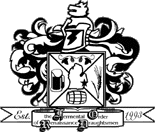 |
 |
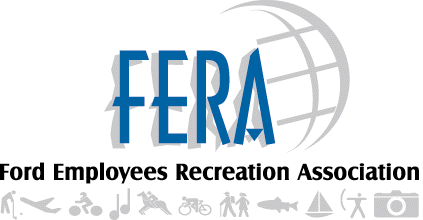 |
 |
 |
 |
| January 2003 | Fermental Order of Renaissance Draughtsmen | Volume 11 Number 1 |
The next meeting will be held back at Bailey's Pub 'N Grille in Dearborn on Wednesday, January 22. Bailey's is located on the southeast corner of Michigan and Mason. Their address is 22091 Michigan Avenue and their phone number is 313-277-3212. As usual, the thirsty hard-core who want dinner will start arriving around 5PM, people will drift in for an hour or so, and we will start our meeting around 6PM.
The winners from the Holiday Ales, English, Scottish Strong Ale, Barleywines and Imperial Stouts Competition are:
| Holiday Ales, English, Scottish Strong Ale, Barleywines and Imperial Stouts Competition | |||
| Place | Name | Style | Points |
| 1 | Chris Frey | IPA | 40.5/50 |
| 2 | Steve Close | Russian Imperial Stout | 38.85/50 |
| 3 | Steve Close | Old Ale | 36.14/50 |
| HM | Anthony Tantillo | Barley Wine | 34.2/50 |
| HM | Chris Frey | Russian Imperial Stout | 34/50 |
| HM | Kathy Loftus & Gabi Palmer | Scotch Ale | 34/50 |
| HM | Steve Close | Barley Wine | 33.5/50 |
| HM | Bob & Kim Barrett | Barley Wine | 32.33/50 |
| HM | Chris Frey | Barley Wine | 30.33/50 |
| HM | Chris Frey | Barley Wine | 28.83/50 |
The winner for the Bitter and Pale Ale AHA competition is:
| Bitters & Pale Ale BJCP category 4 | |||
| Place | Name | Style | Points |
| 1 | Steve Close | English Pale Ale | 38.5/50 |
Editor's Note:In the category of good intentions gone bad, we had people bring in their January entries last month, so that the winner would have time to enter the January 2003 club-only competition. Unfortunately, I didn't get the newsletter out in time and the deadline passed. Sorry Steve.(The entry deadline was January 20, 2003.)

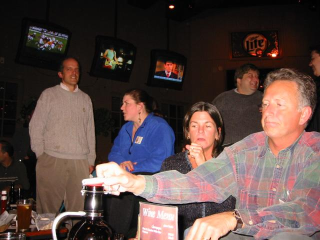 |
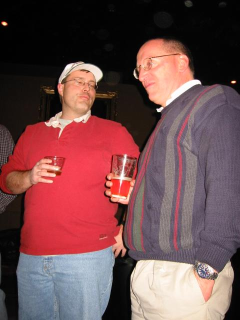 |
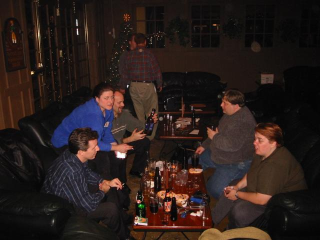 |
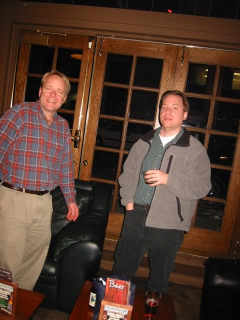 |
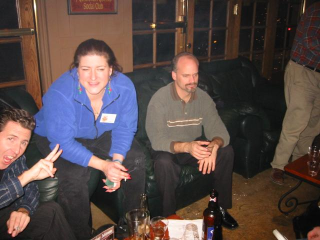 |
The AHA club only competitions take up 6 months work of homebrewing competition. If you have any ideas for the other months marked with a ??? in the calendar of events please let one of the officers know at this month's meeting or send an electronic mail message to Chris, Kathy, Doug, or myself.
Next month's competition is Brown Ale, BJCP category 10. The winner is eligible to enter the AHA Club Only Competition. If I'm not mistaken, the club will reimburse the winner for the cost of entering and shipping a winning sample for judging. The details for the club only competition can be found on the appropriate AHA web page
Bottle and entry forms (useful for non-AHA competitions) can be found there too.10. BROWN ALE
10A. Mild
Aroma: Slight mild malt/brown malt aroma, with some fruitiness. No hop aroma.
Appearance: Medium to dark brown or mahogany color. A few light brown examples exist. May have very little head due to low carbonation.
Flavor: Malty, though not roasty, with a lightly nutty character. Flavors may include: vinous, licorice, plum or raisin, or chocolate. Usually fairly well balanced, though some are sweetly malt-oriented.
Mouthfeel: Light to medium body. Low carbonation and relatively high residual sweetness contribute to a full mouthfeel relative to the gravity.
Overall Impression: A light-flavored, malt-accented beer that is readily suited to drinking in quantity. Refreshing, yet flavorful.
History: May have evolved as one of the elements of early porters. In modern terms, the name "mild" refers to the relative lack of hop bitterness, Originally, the “mildness” may have referred to the fact that this beer was young and did not yet have the moderate sourness that aged batches had.
Ingredients: English mild/brown malt, or a combination of English pale and darker malts should comprise the grist. English hop varieties would be most suitable, though their character is muted.
Vital Statistics: OG: 1.030-1.038
IBUs: 10-20 FG: 1.008-1.013
SRM: 10-25 ABV: 2.5-4.0%
Commercial Examples: Brain's Dark, Banks's Mild, Highgate Mild, Fuller's Hock, McMullin AK, Robinson's Best Mild.
10B. Northern English Brown Ale
Aroma: Restrained fruitiness; little to no hop aroma. May have a caramel aspect to the malt character.
Appearance: Dark golden to light brown color.
Flavor: Gentle to moderate sweetness, with a nutty character. Balance is nearly even, with hop flavor low to none. Some fruity esters should be present; low diacetyl is acceptable.
Mouthfeel: medium-light to medium body, with a dry finish.
Overall Impression: Drier and more hop-oriented that southern English brown ale, with a nutty character rather than caramel.
History/Comments: English brown ales are generally split into sub-styles along geographic lines.
Ingredients: English mild ale or pale ale malt base with caramel malts. May also have scant amounts darker malts. English hop varieties are most authentic. Moderate carbonate water.
Vital Statistics: OG: 1.040-1.050
IBUs: 15-30 FG: 1.010-1.013
SRM: 12-30 ABV: 4-5.0%
Commercial Examples: Newcastle Brown Ale, Samuel Smith Nut Brown Ale, Adnams' Nut Brown Ale.
10C. Southern English Brown
Aroma: Malty and moderately fruity, with some mild malt, brown malt character common.
Appearance: Dark brown, almost opaque.
Flavor: Gentle, moderate sweetness. Malt dominates the balance, but hop bitterness is sufficient to prevent an overly sweet impression. Hop flavor is low to non-existent. Malt flavor will be present, but sharp or roasty flavors are inappropriate.
Mouthfeel: Low to medium body, with a caramel impression.
Overall Impression: A malt-oriented version of brown ale, with a caramel, dark fruit complexity of malt flavor.
History: English brown ales are generally split into sub-styles along geographic lines.
Comments: Increasingly rare.
Ingredients: English pale ale malt as a base with a healthy proportion of caramel malts and often some darker malts. Moderate to high carbonate water would appropriately balance the dark malt acidity. English hop varieties are most authentic, though with low flavor and bitterness almost any type could be used.
Vital Statistics: OG: 1.040-1.050
IBUs: 15-24 FG: 1.011-1.014
SRM: 20-35 ABV: 3.5-5.0%
Commercial Examples: Mann's Brown Ale, Oregon Nut Brown Ale.
10D. American Brown Ale
Aroma: Hop aroma, often citrusy, is mild to strong. Esters and dark malt aspects are mild to moderate.
Appearance: Dark amber to dark brown color.
Flavor: Hop bitterness and flavor dominate the malty richness that is a characteristic of brown ales. Slightly drier than English versions, with assertive hop presence (bitterness, flavor, and aroma).Although malt flavor plays a supporting role, some toasty malt character(or even restrained roastiness) should be evident.
Mouthfeel: Medium body, with a dry, resiny impression contributed by the high hop bitterness.
Overall Impression: A bigger, hoppier, dryer version of brown ale, typically including the citrus-accented hop presence that is characteristic of American varieties.
History/Comments: A strongly flavored, hoppy brown beer, originated by American home brewers.
Ingredients: Well-modified pale malt, either American or Continental, plus crystal and darker malts should complete the malt bill. American hops should be used in generous quantity. Moderate to high carbonate water would appropriately balance the dark malt acidity.
Vital Statistics: OG: 1.040-1.060
IBUs: 25-60 FG: 1.010-1.017
SRM: 15-22 ABV: 4-6.0%
Commercial Examples: Pete's Wicked Ale, Brooklyn Brown Ale, Hart's Pacific Crest Ale, Smuttynose Old Brown Dog, Il Vicino Tenderfoot Brown, Shipyard Moose Brown.
The following article from the January 1998 newsletter celebrates the legalization of homebrew in Michigan.
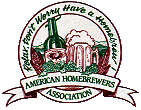 Michigan Homebrewers Toast New Law
Michigan Homebrewers Toast New Law
Boulder, Colo., Dec. 17, 1997 - December 2, 1997 was a day of celebration for Michigan homebrewers, even though most of them didn't realize it.
On December 2, Governor John Engler signed House Bill 4850. This new law permits homebrewing and allows homebrewers to give away up to 20 gallons of their brew.
Most Michigan homebrewers had no idea that homebrewing wasn't statutorily recognized. A few years ago, the American Homebrewers Association® discovered that homebrewing wasn't recognized by some state governments and could be considered illegal. Since then, the AHA has worked with homebrewers in Michigan and other states to legalize the hobby.
The AHA supported Michigan State Representative David Anthony, who sponsored HB 4850. Rex Halfpenny, publisher and editor of the Michigan Beer Guide, worked with the AHA and helped the effort move forward. The AHA is a division of the Association of Brewers that provides information to its members and the general public on the art and science of homebrewing.
In 1978, 45 years after prohibition ended, the federal government statutorily recognized homebrewing. Most states then wrote statutes into their own laws recognizing homebrewing. A few states, including Michigan, did not.
There was never a law in Michigan specifically stating that people couldn't homebrew, but the old statute did specifically state that people could make wine and cider at home. "It kind of left homebrewers out in the cold," Halfpenny said.
Michigan State Senator Christopher Dingell, a lawyer and homebrewer, saw a different problem. Under Michigan law, giving away homebrew was illegal; it was considered selling it. This meant that giving homebrew to a friend or entering it in a competition without holding a license and paying taxes on the beer was illegal. Dingell wrote Senate Bill 505, which made it legal for homebrewers to give away some of their beer. SB 505 was later attached to the newly adopted HB 4850.
Although the new provision doesn't state that homebrewers can now enter their beers in competitions, Halfpenny feels it is implied. "I would infer that this opens the door for taking homebrew and giving it to your friends and entering competitions," he said. "Both of those things are actually giving it away."
The AHA helped Halfpenny in his effort to legalize homebrewing by rallying the people in Michigan, sending mass e-mails and faxes to homebrewers and sending information packets to Michigan legislators. The AHA urged homebrewers to get their local officials involved.
"The American Homebrewers Association placed phone calls to bill sponsors, but it was mainly up to the citizens of the state because it's their voices that really counted," said Mark Snyder of the Association of Brewers.
AHA administrator, Brian Rezac, traveled to Michigan and spoke at the Michigan Homebrewers Rally to draw attention to the campaign. "Michigan is a perfect example of what we need to do to legalize homebrewing in every state," Rezac said. "We need someone to spearhead it, support from legislators and a well-executed grassroots effort. This story could be used as a How to Legalize Homebrewing in Your State primer."
|
Beer Events, Meetings & Competitions
Gabrielle Palmer |
 |
| Ye Olde Brew News
published by the F.O.R.D. Homebrew Club |
|
| Editor:
Tony Tantillo Contributors:
Club Officers: |
F.O.R.D. is a private, non-profit organization of homebrewers. The main goal of this club is to
promote awareness and appreciation of the quality and variety of beer; to share information regarding technique, equipment and skill
required to brew quality homemade beer; and to encourage responsible use of beer as an alcohol-containing beverage.
Howard Klix Jr. 24737 Cushing Ave Eastpointe, MI 48021 Phone: (586) 779-1445
Visit our website at: http://www.be.ford.com/brewers/
current circulation... 125 |